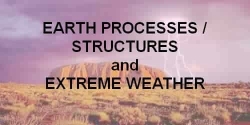Tsunamis and Satellites: Monitoring Disaster from Space
Tsunamis and Satellites:
Monitoring Disaster from Space
article courtesy of EOS Data
Analytics https://eos.com
Tsunamis
Satellite Data & Natural Disasters
Tsunamis & Satellite Data
Challenges
Future perspectives
see
also Tsunamis in e-learning
Tsunamis
Tsunamis, those colossal waves that rise with little warning, are as mesmerising as they are menacing. They sweep across the oceans with a silent, forceful urgency, reshaping coastlines and lives without discrimination. In our quest to coexist with these mighty forces of nature, we've turned our gaze upward — to the expanse of space. Satellites orbiting the Earth offer a unique vantage point, a sentinel in the sky that watches over us. Through the lens of advanced technology, these celestial guardians observe the subtle cues that precede disasters, providing critical insights that can lead to timely warnings.
Satellite Data & Natural Disasters
Satellite technology extends its meticulous surveillance beyond the vast expanses of the ocean, maintaining a vigilant watch over terrestrial landscapes that face the threat of natural disasters. Through a live satellite view, these sophisticated instruments in orbit provide critical insights into the progression of various calamities. They capture the relentless spread of wildfires as they consume forested areas, observe the destabilising effects of landslides that displace earth and communities alike, and track the ominous development of hurricanes as they gather strength over the seas. This continuous stream of high-resolution imagery and data is invaluable, not only for its immediacy but also for the depth of analysis it offers to scientists and emergency response teams. By integrating satellite data into disaster management protocols, authorities can strategise more effective responses and enhance their predictive capabilities. The comprehensive perspective provided by satellites transforms vast datasets into actionable intelligence, guiding both preparedness initiatives and recovery efforts with enhanced precision and foresight. This strategic use of satellite technology significantly bolsters our resilience, enabling a proactive stance against the unpredictable forces of nature.
Tsunamis & Satellite Data
When a tsunami begins to form, the race against time to mitigate its impact starts. Satellites play a crucial role in this high-stakes process, harnessing the power of satellite pictures to deliver real-time updates that are vital for timely and effective disaster response. The initial detection of tsunamis often comes from seismic activity monitored by ground-based sensors. However, satellites enhance this detection system by providing an additional layer of surveillance. They monitor changes in sea level and wave patterns across the ocean's surface, which can indicate the early formation of a tsunami. The ability to see live satellite images allows response teams to track the tsunami's progression toward coastal areas, giving them a precious lead time to activate warning systems and initiate evacuation procedures.
Moreover, satellites equipped with radar and optical sensors can capture the aftermath of a tsunami, assessing the extent of flooding and the impact on infrastructure. This live satellite view of Earth is crucial for coordinating rescue and relief efforts, helping to direct resources to the most affected areas swiftly and efficiently. By analysing the damage and mapping affected regions, satellites provide essential data that supports recovery and rebuilding efforts, ensuring that help reaches those who need it most. Furthermore, satellite data is instrumental in improving tsunami models and forecasts. By gathering historical data on tsunamis and their impacts, scientists can refine their predictive models, enhancing the accuracy of future forecasts. This ongoing analysis contributes significantly to our understanding of tsunami dynamics, leading to better preparedness strategies that can save lives and reduce economic losses. In this way, satellites not only offer a bird’s-eye view of disaster but also empower humanity with the knowledge and tools to face these formidable natural phenomena with increased confidence and capability.
Challenges
Despite the advanced capabilities of satellite technology, capturing the full scope of a tsunami in real time presents several challenges. The very nature of tsunamis (rapid and often occurring under adverse weather conditions) can impede the effectiveness of satellite observations. For instance, cloud cover can obscure the satellite view, making it difficult to obtain clear images of the unfolding disaster. This is particularly problematic as tsunamis can trigger severe atmospheric disturbances, further complicating the clarity of satellite feeds. Additionally, the timing of satellite passes over specific regions may not always align with the onset of a tsunami. Satellites in orbit follow fixed paths and schedules, and if a tsunami occurs outside of these observation windows, delays in data acquisition can occur. This gap can be crucial, as even a few minutes can make a significant difference in the effectiveness of early warning systems and emergency responses. Furthermore, the resolution of satellite images can sometimes limit the detail with which small-scale or subtle changes in wave patterns and water levels are detected. While technology continues to advance, the quest for finer resolution and more frequent revisits remains a significant hurdle in utilizing live satellite view to its full potential during tsunami events. These challenges highlight the need for continuous improvement in satellite technology and the integration of additional data sources to enhance our readiness and response capabilities in the face of such unpredictable natural disasters.
Future Perspectives
As we look to the future of tsunami monitoring, the horizon is bright with the promise of technological advancements that will enhance the effectiveness of satellite imagery. The development of more sophisticated satellites equipped with higher resolution cameras and faster data processing capabilities is set to revolutionise our abilities to track natural disasters. These advancements will allow for more detailed and timely observations, reducing the impact of obstacles like cloud cover and the limited timing of satellite passes. Moreover, the integration of artificial intelligence and machine learning into most current satellite images analysis promises a leap forward in predictive capabilities. These technologies can help in rapidly analysing vast amounts of data to detect subtle changes in the ocean that precede tsunamis, potentially leading to faster and more accurate warnings. Collaborative international efforts are also expanding, with more countries investing in satellite technology and sharing data to create a more comprehensive global monitoring system. This collective approach not only broadens the scope of data but also enhances the speed and accuracy with which it can be analyzed and acted upon. The future of tsunami monitoring with satellites is geared towards creating a more resilient global community, equipped to respond to tsunamis with greater agility and informed precision. By harnessing the power of advanced technologies and international cooperation, we are paving the way for a safer interaction with our dynamic and often unpredictable planet.

